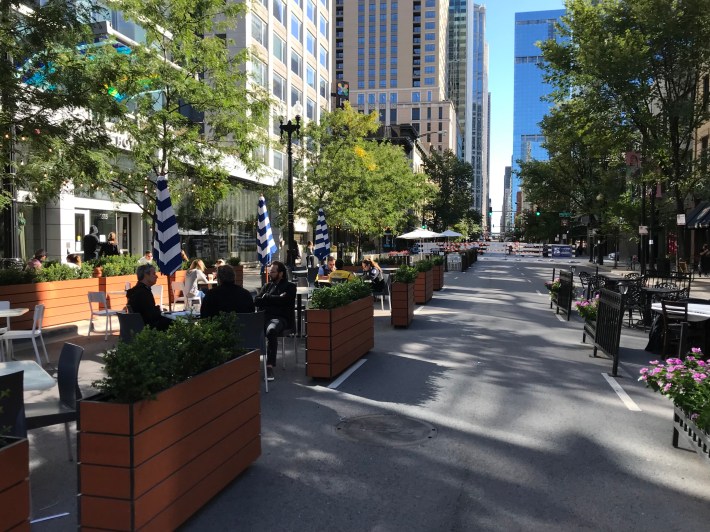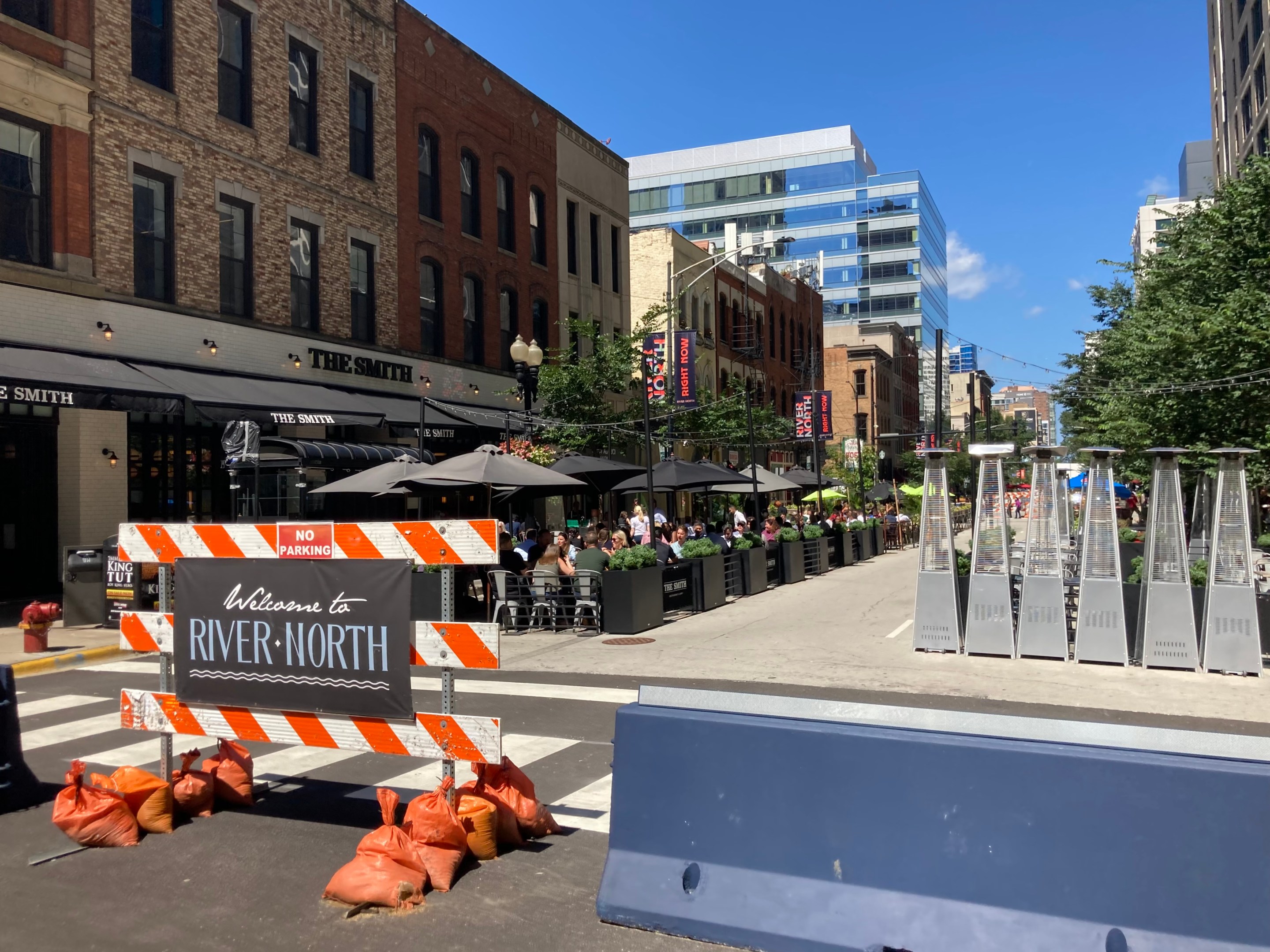Streetsblog Chicago cofounder Steven Vance contributed to this article.
One of the silver linings of the COVID-19 regulations was that the ban on indoor dining forced Chicago officials to experiment with something they should have been doing all along. From Little Village to Rogers Park, popular restaurant strips were pedestrianized to make room for cafe seating in the street as part of the city's Expanded Outdoor Dining program, a strategy that proved hugely successful.
Unfortunately, many of these well-used car-free dining districts, such as Rush and Division streets on the Near North Side, and Broadway in Lakeview, were eliminated as society reopened from the pandemic. That was largely due to the mistaken belief that mostly allocating street space to move and store large metal boxes is a more important and profitable use of right-of-way than making room for people.
One outlier has been the three-block stretch Clark Street between Grand Avenue and Kinzie Street, home to popular eateries like Beatrix, Ema, Frontera Grill, and RPM Steak. (There's also a cannabis dispensary on this block that uses the extra roadway space for queuing customers under a shaded canopy who would otherwise be waiting on a narrow sidewalk.)
Almost three years after COVID hit Chicago, this pedestrian street is still going strong, both during the summer and in colder weather, thanks to heat lamps and tents set up in the street. Having the extra room to seat more customers is obviously bringing more sales to these establishments, and therefore generating tax revenue that benefits all Chicagoans. The strip will remain car-free until November 18 of this year.

Unfortunately, a short-sighted neighborhood community group wants to kill the goose that laid the golden egg. The organization is lobbying Lori Lightfoot to cancel plans to permanently pedestrianize this segment of Clark during the warmer months.
As reported by the Chicago Sun-times' Fran Spielman, on October 27 Deborah Gershbein, president of the influential Streeterville Organization of Active Residents, wrote the mayor to say that her group is “strongly opposed” to the proposal. Gershbein argued that when the Medinah Temple, located a few blocks northeast of the car-free restaurant strip at Ohio Street and Wabash Avenue, reopens as a temporary casino, there will be a traffic nightmare.
"It will cause even more major traffic gridlock if the Clark Street [pedestrianization] continues," she wrote. "Consequences of this [car-free district] include delayed response times for emergency vehicles, public transportation and delivery vehicles."
Gershbein noted that Clark is a "major north/south arterial street that carried 21,000 cars-per-day" before the vibrant outdoor dining area was established. She insisted that those vehicles “did not go away” but instead were “re-routed into Streeterville and River North... [Since] traffic is back to a more normal level, it is time to re-open Clark Street."
"Closing Clark Street between Grand and Kinzie impedes resident and worker ability to travel out of Streeterville into River North and beyond... We request that you reconsider the proposed ordinance and to not include Clark Street in that ordinance." She has a point there: Clark is basically the only street available for southbound driving in the vicinity, other than Orleans Street, Franklin Street, Wells Street, LaSalle Street, State Street, Wabash, Rush Street... There are no east-west street closures in this district.
A spokesperson from the mayor's office told Spielman Expanded Outdoor Dining “has supported hundreds of restaurants since its implementation in 2020.” The ordinance would make the program permanent each year between May 1 and Halloween.

Local alderperson Brendan Reilly, an opponent of the casino, told the Sun-Times he's also against making the the pedestrianization of Clark automatic each year, and is worried about the gambling facility creating more traffic jams. But he conceded that his office has only heard a "handful of complaints" about Clark going car-free, while there's been "significant positive feedback from most River North residents."
Reilly's ally neighboring alder Brian Hopkins (2nd) said the quiet part out loud, telling Spielman he is “adamantly against” the ordinance to get rid of "aldermanic prerogative" over whether streets should be pedestrianized or not. Aldermanic prerogative, the de facto ability of City Council members to veto projects in their districts, was supposed to have been eliminated by an executive order Lightfoot signed on her first day in office, but it still frequently interferes with livable streets initiatives.
Gershbein's claim that traffic is returning to "normal" on the Near North Side, and therefore cars must be allowed on Clark at all times, needs to be unpacked. There is no "normal" level of traffic that we have to accept on city streets, let alone bring back the noise and pollution of 21,000 cars a day where people are eating. Rather, we can choose to make streets less car-centric, which will help reduce the amount of driving and the demand for road space for automobiles, a phenomenon known as "traffic evaporation."
It's worth noting that the two blocks of of Clark north of the pedestrian district, and the two blocks south of it, are often relatively devoid of cars nowadays compared to the pre-COVID situation. Drivers have used the neighborhood's extensive street grid to find other routes. There's no reason we need to return to having a car-choked Clark year 'round.






